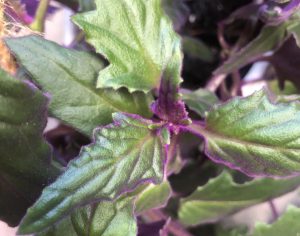It is well known that plants and gardening can promote wellbeing. Most of you reading this are likely gardeners or plant enthusiasts who have first hand experience with the myriad benefits caring for our green friends can impart. Caring for plants can improve our wellbeing by reducing stress, anxiety, depression, and insomnia. The presence of plants can decrease cortisol levels in our bodies. Why not bring these benefits into our living space? Houseplants engage our senses through color, touch, fragrance, and beauty, and typically require less inputs than outdoor gardens.
String of Hearts or Rosary Vine, Ceropegia woodii
 The delicate purple vining stems of this succulent are adorned with green-marbled heart-shaped leaves that have purplish undertones. It is most often planted as a hanging plant but can also be trained up a trellis or topiary frame. String of hearts is easy to grow in a west or south facing window; stronger light results in more vibrant color. Because it is a succulent, it requires very well-drained soil and prefers to dry out thoroughly between deep watering (overwatering is a sure way to cause decline). Tubers of this plant can fill the pot, resembling rosary beads- hence it’s common name of Rosary Vine. It is happiest in a crowded pot and is easy to propagate by cuttings or tuber division. I find it easiest to place a pot of soil beneath the trailing plant and it will root on it’s own. Once it is sufficiently rooted, it can be cut from the parent plant.
The delicate purple vining stems of this succulent are adorned with green-marbled heart-shaped leaves that have purplish undertones. It is most often planted as a hanging plant but can also be trained up a trellis or topiary frame. String of hearts is easy to grow in a west or south facing window; stronger light results in more vibrant color. Because it is a succulent, it requires very well-drained soil and prefers to dry out thoroughly between deep watering (overwatering is a sure way to cause decline). Tubers of this plant can fill the pot, resembling rosary beads- hence it’s common name of Rosary Vine. It is happiest in a crowded pot and is easy to propagate by cuttings or tuber division. I find it easiest to place a pot of soil beneath the trailing plant and it will root on it’s own. Once it is sufficiently rooted, it can be cut from the parent plant.
Its tiny, waxy, pinkish, vase-like flowers are lined with small hairs that serve to trap tiny flies. When the hairs whither away, the fly is released with a mass of pollen grains to transfer to the next flower visited. Because this plant is related to milkweed, the resulting seed pods resemble tiny milkweed pods.
Purple Passion Vine, Gynura aurantiaca

Native to Indonesia and Java, this unique houseplant has soft, purple velvety leaves and stems. Prefers bright, indirect or filtered sunlight– mine thrives with the screened protection of an east-facing lanai. Keep soil moist, but well-drained—it has a tendency to rot if too wet in the cooler months. May produce tiny orange flowers, but they are malodorous and therefore typically removed. The purple passion vine grows rather quickly and adds a low-maintenance splash of color and texture to a room or patio. They can be susceptible to aphids, scale, mealybugs, whiteflies, and spidermites, however these are all relatively easy to treat with neem oil or insecticidal soap.
Hindu Rope Vine, Hoya carnosa ‘Compacta’

Native to East Asia and Australia, this curly leaved version of the wax plant (Hoya carnosa) can be more challenging to find and is priced at a premium. This is due to this succulents slow-rooting nature and snails pace growth rate– about 6 inches a year. Once it takes off though, you will have a gorgeous and relatively low-maintenance vine. The unique curly leaves somewhat resemble a tortellini made of green wax, and the flowers grow in a ball-like cluster of tiny start-shaped fragrant pink and white flowers. Hoyas prefer bright, indirect light with high humidity (not a problem in Florida!). It’s succulent nature prefers very well-drained soil, infrequent watering, and prefers to be potbound. It can be susceptible to mealybugs, scale, or aphids, all of which can be treated with horticultural oils or insecticidal soaps.
References:
https://plants.ces.ncsu.edu/plants/gynura-aurantiaca/
https://wexnermedical.osu.edu/blog/houseplants-are-good-for-your-mental-health
Source: UF/IFAS Pest Alert



